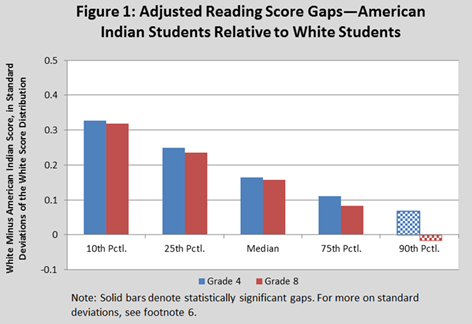Staff at the Center for Indian Country Development (CICD) recently completed a strategic plan covering 2016 to 2020. Based on advice from the CICD’s Leadership Council and other experts, we are planning to focus our time and resources on issues in four main areas: land, business and entrepreneurship, education, and homeownership. One of our specific goals regarding education will be to assemble and analyze data on educational outcomes in the K-12 schools that serve Indian Country. In addition, we plan to review and disseminate related findings by other researchers.
A helpful starting point for our work can be found in “The Academic Achievement of American Indians” by Stefanie Fischer and Christiana Stoddard, published in 2013 in the Economics of Education Review.1 Using two sets of data collected by the National Center for Educational Statistics, the broad National Assessment of Educational Progress (NAEP), and the newer and more targeted National Indian Education Survey (NIES), they produce the first multistate, multivariate assessment of American Indian test score performance relative to other racial and ethnic groups. An interesting feature of the NIES is its racial identification—both the students and their schools independently identify the students as American Indian/Alaska Native or not, and the identities they assign may differ. I will focus on Fischer and Stoddard’s analysis of the data based on race as assigned by school administrators, mainly because it is the most straightforward way to compare across racial and ethnic groups on this basis.2
The NAEP collects the results of standardized reading and math exams from a random sample of close to 150,000 students in each subject for each of the grades 4, 8, and 12. The NAEP is “designed to be representative of public school students and schools in each state,” making it “the largest nationally representative exam and … best measure to compare students across areas in the United States.”3 Nonetheless, because American Indians and Alaska Natives are only about 1 percent of U.S. public school students, the NAEP provides limited information about them. To remedy this limitation, the NIES provides “a nationally representative sample of American Indians in 4th and 8th grade for 2005, 2007, and 2009” in all schools funded by the Bureau of Indian Education as well as in selected schools in states with large American Indian populations. Fischer and Stoddard analyze the combined 2005–2007 data for 4th and 8th grades from the NAEP and NIES for the 48 contiguous states.4
Achievement Gaps
Fischer and Stoddard’s paper includes a detailed and nuanced discussion of the data and achievement measures. Note that they compute math and reading achievement gaps by comparing school-identified American Indian students, black students, and Hispanic students, respectively, to white students. (Asian students are omitted.) In this context, an achievement gap refers to the amount by which the typical test score for a non-white group lies below the typical test score for white students, with the following results:
- Typical achievement gaps: Comparing school-identified American Indian students to white students, Fischer and Stoddard find that test scores that would place a student in the middle of the results for American Indians would rank only at about the 25th percentile for whites.5
- Changes from 4th to 8th grade: The authors find that “As with other groups, the [American Indian] gaps also appear to be larger in 8th grade than in 4th grade for math. For reading, gaps are somewhat smaller in 8th grade than in 4th grade for American Indian and Hispanic students, while remaining relatively unchanged for black students.”6
Underlying Factors
Fischer and Stoddard developed additional insights by looking behind the average achievement gaps summarized above. When they statistically relate family demographics and school-related factors to achievement gaps, they find:
- Demographic differences: According to Fischer and Stoddard, “the demographic and family characteristics of American Indian students are similar to those for black and Hispanic students, with more than three quarters eligible for free and reduced price lunches, about a quarter living in homes with less than 10 books, and with parental education levels that tend to be lower than those for black students but higher than those for Hispanic students.”7
- Possible demographic effects: “Socioeconomic characteristics (free lunch status, number of books in the home, and parental education) explain relatively more of the gap for American Indians than for black or Hispanic students.”8
- Possible school effects generally: The characteristics of the schools that American Indians attend are more clearly correlated with their achievement gaps than is the case for black and Hispanic students, which “may suggest that school characteristics play a larger role for American Indians.”9
- Possible school effects specific to reservations: For American Indian students, “on-reservation gaps are about 40 percent larger than off-reservation gaps.” However, in analyzing this difference, it is “difficult to disentangle the effects of school characteristics, school location, and student race.”10
- Much smaller score gaps for high-achieving than low-achieving American Indian students: Fischer and Stoddard find that white-American Indian score gaps are markedly lower among higher-achieving students than among lower-achieving students. This is true for both raw scores and scores that are adjusted for differences in socioeconomic and school conditions. For example, the 4th and 8th grade gaps in raw reading scores for the “talented tenth” (white and American Indian students at or above the 90th percentile of their respective score distributions) are about half as large as for students in the lowest tenth. For math, the raw score gaps at 4th and 8th grade decline by about a third between the 10th and 90th percentiles. After allowing for the effects of socioeconomic and school factors (using a method called “quantile regression” that allows these effects to differ between higher- and lower-achieving students), Fischer and Stoddard again find much smaller gaps for high-achieving American Indian students. As shown in the accompanying graph of adjusted reading score gaps (Figure 1), white-American Indian reading score differences are statistically significant and materially large for students in the bottom 10 percent. However, the adjusted gap steadily falls as the achievement level rises, until it becomes effectively zero at the 90th percentile. Adjusted math score gaps remain significant even for high-achieving American Indian students, but they also fall sharply with achievement, as shown in Figure 2. As Fischer and Stoddard discuss in more detail in their paper, the extent to which these adjusted gaps close with achievement is much stronger for American Indian students than for black or Hispanic students.


Fischer and Stoddard’s research provides an important benchmark for measuring and addressing American Indian academic achievement gaps. They show that the gaps are significant and merit attention. In addition, their ability to statistically account for much of the gap with socioeconomic and school-based factors may help identify remedies, in the form of programs that mitigate these underlying factors. For example, their results demonstrate that much of the lifetime achievement gap for American Indians emerges by 4th grade, suggesting the potential importance of efforts that begin early in childhood.
More work will be needed to clearly identify the causal relationships that lead to the gaps they document and to find efficient solutions. The CICD intends to contribute to that work.
Endnotes
1 Fischer received her Ph.D. in the Economics Department at the University of California Santa Barbara in 2015. Stoddard is Professor of Agricultural Economics and Economics at Montana State University.
2 Results using student-assigned race are discussed and compared to the school-assigned results in the original paper, which also includes additional interesting results not summarized here. Their comparison of school- versus student-assigned identities is especially valuable for American Indian students given their finding that “The match between self- and school-identification is lower for American Indians than for any other [racial or] ethnic group.”
3 Fischer and Stoddard, p. 137.
4 Ibid., (pp. 137–138). They also explain there that they “drop observations from Hawaii and Alaska because populations and institutions for Native students in these states are significantly different.”
5 Specifically, they “find a raw achievement gap [in 4th and 8th grade for American Indians relative to whites, with the American Indian score lower] of about 60 to 70 percent of a standard deviation for both math and reading. These gaps are smaller than the gaps for blacks and similar to the gap for Hispanics.” [The standard deviation quantifies the degree to which individual measurements spread out around the overall average, or mean. For example, if measurements are normally distributed (generally a reasonable approximation for test results), about half of the individual measurements are within two-thirds of a standard deviation above or below average, and close to two thirds of the measurements lie between one standard deviation below and one standard deviation above average.]
6 Fischer and Stoddard, p. 148.
7 Ibid., p. 138.
8 Ibid., p. 142.
9 Ibid., p. 142. Alternatively, it may be that American Indians disproportionately choose to enroll in different types of schools; see ibid.
10 Ibid., p. 145. More specifically, they report that achievement “[g]aps on reservations are about 16–20 percent of a standard deviation larger than off a reservation (with the exception of reading in 8th grade).”





